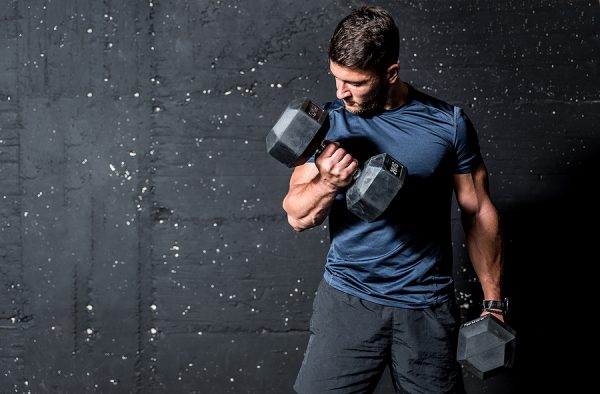For years, bodybuilders have preached about the importance of the mind to muscle connection.
Physique athletes believe that improving your ability to mentally concentrate on the muscle you’re training, and focusing on feeling the muscle contract, will increase activation in the target muscle and reduce the involvement of secondary muscles, and that this in turn will increase muscle growth.

Scientists have confirmed that there’s something to it. In one study, a group of football players were hooked up to an electromyograph (EMG) machine while doing the bench press and given specific verbal instructions to “focus on the chest muscles.”
We know that the bench press is a compound exercise involving the pectoral muscles of the chest, as well as the front deltoid and the triceps. But with a simple verbal cue which shifted the lifter’s mental focus, the muscle activity (measured by EMG) in the pectoralis major increased by 22%. Even more interesting, when instructed to focus on the triceps, the muscle activity in those muscles increased by 26%.
This was not a lone finding. In a study from the University of South Carolina, subjects were able to voluntarily increase activation of the latissiumus dorsi muscles (the “lats”) after receiving professional instruction on how to perform the exercise, along with palpation (the coaches touched the specific area of the upper back muscles they wanted to focus on). The biceps do a lot of work in pulling exercises, but the goal here was to use the mind to activate the back more and the arms less. That’s exactly what happened. Lat activation increased by 17.6%
Another EMG experiment was performed by Bret Contreras who was studying glute exercises, which are of interest to many athletes as well as female fitness competitors. In the low back extension exercise, the entire posterior chain is trained, including the low back, hamstrings and glutes. While doing the same exercise, with the same form, when instructed not to focus on extending the hips using the glutes, the maximal voluntary isometric contraction in the glutes was only 6%. When the exerciser was told to focus mental attention on using the glutes, EMG muscle activity went up to 38%!
Studies like these, combined with real world experience, have given support to the idea that using the right kind of mind to muscle connection can help bodybuilders and athletes build more muscle. But until recently, it was still only theoretical. The EMG studies showed that you can indeed learn to activate specific muscles more strongly by using instructional cues to shift mental focus onto those areas. However, those studies didn’t actually measure muscle growth over time.
It’s logical that increasing muscle activation would help increase muscle growth, but it wasn’t until 2018 that a long-term study confirmed it. A research group lead by Brad Schoenfeld compared the results in two groups of lifters who were given different instructions during their workouts. One group was told to focus internally and “squeeze the muscle” while the other was instructed to focus externally and think about “getting the weight up.” After 8 weeks, the group that focused internally had greater biceps growth (12.4% vs 6.9%).
Bodybuilders call it the mind to muscle connection. The name researchers use is “Attentional focus.” Simply defined, it’s what you think about (where you place your attention) during a particular movement or activity, including lifting weights.
There are two basic types of attentional focus – internal and external.
An internal focus is when you think about the movement of your body, or as bodybuilders suggest, you focus on a body part when you do an exercise. During a flye exercise for example, you might concentrate on feeling your pectoral muscles squeeze into a tight contraction. By contrast, an external focus might be pushing the floor away from you during a deadlift or driving up the barbell during a press. Basically, internal focus is feeling the muscle, external is focusing on lifting the weight.
It’s important to point out that an internal focus is not always the ideal approach during all types of exercise. Many studies in physical therapy and sports training have found that an external focus is usually superior for improving physical skill and performance.
It also appears that when you’re training for strength with heavy weights, using an external focus with different types of cues may work better. In the football player study, they discovered that increasing muscle activation using mental focus on the target muscles was more effective during sets with light to moderate weights and less effective with heavy weights.
In a maximum bench press, or when doing low rep heavy lifts, the athlete might think, “drive up,” “get the weight up,” push hard” or simply focus on the outcome – lock out and finish the lift. In Olympic lifting the focus is on lifting explosively, not contracting a specific muscle, and coaches create all kinds of external cues to guide the athlete, such as “big drive,” “fast elbows,” “push the ground, “squeeze the bar” and so on.
A key point to remember is that bodybuilding and weight lifting are not the same thing. Strength athletes focus on lifting the weight. Bodybuilders focus more on feeling the muscle. When the goal is muscle growth (hypertrophy), an internal focus may be ideal. Simply stated, bodybuilding is about putting your mind into the muscle and one of the goals in bodybuilding is strengthening the mind-muscle connection.
There are still some debates about this topic, but most confusion comes from failing to understand the differences between sports skill training, strength training and physique training. The bottom line is, your mental focus should match the goal of your training.
Let’s assume the goal of your training is developing your physique or building muscle and you’re convinced that you need to get better at controlling your mental focus. The big question is how specifically do you do it? It’s one thing to tell someone to focus on a muscle or “feel the muscle working,” but the irony is, that’s exactly what many trainees have a hard time doing.
Most beginners complain that they don’t feel a strong contraction in their muscles while training and they don’t know how to feel them, even though by all outward appearances, they’re doing the exercise properly. It’s easier to direct mental focus to a muscle when it’s an isolation exercise like a bicep curl or a pec flye. On the compound exercises where multiple muscles are working, it can remain a challenge even in experienced lifters.
In the Schoenfeld study, an arm and a leg exercise were tested. An interesting finding was that there was no difference in muscle growth in the lower body. Only the bicep muscles grew more in the internal focus group. The subjects were not experienced bodybuilders and the researchers suggested that for the average untrained person, neuro-muscular reeducation is easier in the arms than in the legs. Most people have greater mental control over their biceps than their quads.
The good news is, developing a better mind to muscle connection in any muscle is a learnable skill that improves with practice. But you have to work on it deliberately and have a system for doing it. As you’ve already learned, verbal instruction on how to perform an exercise properly and verbal cues to focus on the muscle are simple and effective methods, but there are many other techniques you can use.
Here are ten of the best ways to build your mind to muscle connection for building more muscle. These are based on both the science as well as the real-world experience of physique athletes and bodybuilders.
1. Study muscle anatomy, muscle function and the body movements each muscle controls.
A good place to start is with muscle anatomy and function. You must learn what your muscles look like, where they attach and how they work to produce movement. You must also learn which exercises are best for each body part. For compound movements, you’ll want to know all the muscles involved, including which muscles are the prime movers and which are the secondary movers (assisting muscles).
Your education should include reading, but here’s something that may help even more: Study illustrations of muscle anatomy. Frederick Delavier’s Strength Training Anatomy is an excellent book on this subject because it’s an exercise anatomy book. It’s also technically accurate while still easy for a layperson to use.
2. Learn how to do every exercise with perfect form.
Even if you try putting mental focus on a muscle during an exercise, if you’re doing an exercise wrong, you’re reducing the muscle activation and involving muscles you didn’t intend to work. Using proper form is important for staying injury-free, and it’s also important for proper muscle targeting.
Use every tool and resource you have available to learn about proper exercise form – books, articles, videos, coaches, experienced training partners – use them all or whichever suit your learning style the best. Hiring a coach or trainer, at least for a short while to learn proper exercise technique is one of the best investments you can make. Today you can even get form checks online by video taping yourself and uploading to an online support group or an online coach.
A great place to learn both the basics and the finer points of perfect exercise form is right here in the Burn the Fat Inner Circle exercise instruction department, where we teach hundreds of exercises, showing not only proper form but also the anatomy and muscles involved: Burn The Fat Inner Circle Exercise Index (members only)
3. Learn to use cues (verbal or mental self-instructions) for each exercise.
Many studies have shown how receiving specific verbal instructions before an exercise and verbal cues during an exercise (from a coach) can increase the activation of a specific muscle.
A trainer or coach can help, but you can learn and practice this on your own as well. The cues you give to yourself (mentally in the form of self-talk) may be short phrases and even single words that direct where you focus, what you feel and how you perform an exercise to get more out of it.
As simple as it sounds, “focus on the chest” (or whatever muscle you’re working), has been proven effective for increasing muscle activity. Other simple words that are used as internal focusing cues include “squeeze,” “contract”, “flex,” “tight,” “hold” and so on.
In addition to words and phrases that direct your focus to a specific muscle, you can also use cues that put your focus on optimizing the exercise form or movement, which will in turn increase how much you can feel the muscle contract.
For example, one reason so many people don’t feel their lats working on exercises like lat pulldowns or seated rows is because their arms (biceps and other elbow flexors) are doing too much of the work and they’re rounding their back. By giving yourself a cue such as “hands like hooks” and “chest up, arch back, squeeze shoulder blades together,” the lats contract harder and the arms work less.
Describing all the possible cues for every exercise is far beyond the scope of this article, but when there are important cues, they should be mentioned in any good exercise tutorial, as they are in our Burn the Fat Inner circle exercise instruction articles. In addition, many of the best cues like “focus on the ______ (muscle)” will work for almost every exercise.
4. Visualize
Visualization is a well-known mental training technique with many applications, and helping to improve the mind to muscle connection is one of them. This is another method of directing focus, it’s simply done with mental imagery not words alone.
In a study on abdominal training, subjects were instructed not only to feel the abs contracting or squeeze the muscles, they were also given specific instructions on how to visualize the rectus abdominis and oblique muscles working. The instructions were given before the workout and then repeated verbally during the exercise.
A control group was told to focus on the exercise movement (the form), but was given no instructions pertaining to any specific muscles. The subjects that visualized their abs contracting were able to significantly increase muscle activity as measured by EMG.
This is where the study of muscle anatomy pays off, because you can visualize a muscle better when you’ve seen anatomical drawings. Watching videos of highly developed, lean physique athletes performing exercises with the muscles showing can also help.
5. Clear your mind of all worldly concerns when you step in the gym.
Developing mental focus is a broader subject than simply directing attention to a muscle during a set. At a higher level, it means your mind must be free of all concerns other than training when you’re in the gym. If your mind is wandering off on something else, it’s not on the working muscles.
Before you step in the gym, you must leave everything happening in your life behind you, at least temporarily. How? Tell yourself, “This is my time.” Tell yourself, “This (the gym) is my sanctuary.” Then put all your focus on the workout.
This may sound challenging at first if you’re stressed about events in your life, but it’s not difficult if you re-frame it this way: look at the gym as your source of stress relief – make it your escape or your way to blow off the steam. Even if it’s only temporary relief, that’s still vitally important, because it’s not stress, but continuous stress that’s most harmful.
By thinking of the gym as your sacred space and time, you kill three birds with one stone – you get another motivational reason to go to the gym, you relieve stress, and you improve your focus on your workouts.
6. Eliminate distractions in the gym.
Once you’re in the gym, eliminate every distraction you can. Start by not keeping your phone in your pocket. Leave it in the locker. Better yet, leave it in the car. Best of all, leave it at home. If you use a phone for a workout app, consider switching to a paper journal and a pen. If you absolutely must use it, put the setting on busy or airplane mode so there is no internet connection and no incoming notifications.
Some people consider music a distraction, but your response may vary. Using music with headphones helps a lot of people block out externals and increase mental energy. There are TVs in almost every gym. Do not watch them unless you’re doing cardio. The last thing you need to hear in the gym is the news. When you lift, focus only on lifting. There are racks of magazines in the gym. Do not read them. Visualize the next set. Then do it.
If you ever wondered why some bodybuilders train in a hoodie, pulled all the way over, it may not be a fashion statement, and it may not be cold. One reason is because it blocks peripheral vision and fewer distractions enter their awareness (it’s like a “tunnel vision” effect). It may seem anti-social, but serious bodybuilders often make it a point to not make any eye contact either.
You may or may not be that intense during your workouts, especially during rest periods between sets, and the social aspect of the gym is important to some people (as are training partners). But at the very least, the second you start each set, you must learn to “flip a switch” and focus on the task in front of you, shutting out all distractions during the set.
If your gym is a social scene or just plain mobbed, consider a more serious gym where people go to train, not gossip. If you have a basement, garage, or extra room in your home, think about whether home gym training might be best for you.
7. Decrease your repetition speed.
While a normal rep might take 1 to 2 seconds to lift the weight and 2 to 3 seconds to lower it, slowing that down by even a second or two can increase your ability to feel the muscle contracting because of the longer time under tension and the reduced use of momentum. Go even slower if you find it helps.
It can be especially helpful to put extra emphasis on the eccentric (lowering) part of the movement, making that part of the rep even slower than the concentric (lifting) movement. In addition to helping improve the mind to muscle connection, studies have shown that eccentric-emphasis training may help stimulate additional muscle growth.
Slowing your rep tempo usually means you have to reduce the weight, which might make you feel like you’re going backward in progression. However, what you gain in increased mind to muscle connection from a period of slower rep training will be worth it because when you go back to regular speed reps, you’ll find you’ve improved your ability to feel a muscle working at normal rep speeds and moderate weights.
8. Keep the weights light at first and use internal focus for hypertrophy training.
Many trainers advise their clients to lighten up the weights at first until the exercise form is mastered. This is always good advice for learning new exercises. It also applies to strengthening the mind muscle connection.
As a general rule, using an internal focus on the working muscle is most effective when the weights are on the moderate to light side. It’s simply more difficult to squeeze a muscle and feel it contract when the loads are heavy. On the heavy, lower rep workouts, focusing on completing the lift and using cues that help you lift the most weight possible are usually preferable.
If you’re training for physique goals yet you prefer to include heavier training, you can use your warm up sets as an opportunity to practice the mind muscle connection. When used specifically for improving mental focus these are sometimes called activation sets, because you put all your attention into squeezing and contracting the muscle hard even though the weight is light. It’s almost like posing or flexing a muscle.
As you get better at doing this with lighter weights, you’ll improve your ability to direct neural drive to the target muscles when you go heavier as well. If you were not doing warm up or activation sets with mental focus, try it and see if it improves your performance. You may be able to feel the muscle more or even lift more on your heavier sets by getting better at activating the target muscles with lighter sets.
You could also do “back off sets” at the end of a workout after the heavy work is done. These sets again, can be done with an internal focus. An added benefit is the pump and metabolic stress which may enhance muscle growth beyond using heavy weights alone.
9. Use the peak contraction principle.
If you understand intellectually what it means to contract or squeeze a muscle or to focus your attention on a muscle, but you still can’t really feel it, what then? Another technique that helps is peak contraction. This is a classic bodybuilding principle that involves holding the weight in the fully contracted (muscle shortened) position for a brief time, which helps strengthen the neuro-muscular pathway.
Some people call this the iso-hold or static hold technique, but there’s a difference between the static hold and peak contraction methods. A weight can be statically held in any part of the range of motion – the top, middle, or bottom as a high intensity training technique. Peak contraction refers specifically to holding the weight and squeezing in the fully contracted position on specific exercises where there is maximum resistance at that point in the range of motion.
For example, a squat exercise is not a peak contraction movement for the quadriceps because at the top of the exercise, your knees are locked out and there is no resistance on the thigh muscles. A leg extension on the other hand is a peak contraction exercise because there is maximum resistance at the top of the movement where the quads are fully contracted.
Even if you hold for only one second, you’ll gain some benefit, but for maximum results, you’ll want to hold the full contracted position and squeeze for at least 2 or 3 seconds before lowering the weight back down. Some coaches recommend holding the contracted position 4 to 5 seconds or more, just keep in mind that if you go for longer holds, it may force you to reduce the weight substantially.
Some people take this idea further and flex the muscle in between sets. Even though no weight is being used, flexing between sets can increase muscle control and this is one of the reasons you see so many bodybuilders posing in the gym. That’s right folks, it’s not narcissism! (well… usually not).
10. Meditate and practice mindfulness
Meditation has a long list of benefits. Many people notice that it helps them develop their powers of concentration and increase their ability to bring attention back to a center of focus after it has wandered.
An extension of meditation is to practice mindfulness in everything you do. This means being present and having your mind immersed in every moment, not wandering somewhere else. “Wherever you are, be there.” This goes for your entire time in the gym, and most important of all, during each set.
Another great place for mindfulness is when you’re eating because you do it multiple times a day (many opportunities to practice) and it will support your training efforts. When you eat, do nothing but eat. Do not read, do not check facebook, do not watch TV. Just eat. Focus on the taste of the food and especially how full you feel.
Focusing your attention on one thing at a time is a skill and if you practice it diligently, you can get very good at it. When applied to your lifting, it will create great power that will not only enhance your training but also transfer to other areas of your life.
Conclusion
There’s no question that the mind to muscle connection is real. Studies show that you can increase the strength of a muscle contraction and even activate one muscle in a compound exercise more than others simply by shifting your mental focus. The most recent research backs up what bodybuilders and physique athletes have believed for years – that focusing your mind on the muscle can actually increase muscle growth.
It will take a lot more research to determine for sure how much an internal focus during training can increase muscle growth. So far there’s only been one study that tracked the effects over time and measured an increase in muscle thickness. The results are promising and exactly what we’d predict, but research in this area is still in its infancy.
On the other hand, we also don’t know how far the powers of the mind reach. The benefits of controlling and directing our thoughts may go beyond what can be easily tested or measured scientifically, so this is a frontier each person will have to explore for him or herself.
By Tom Venuto,
Author of Burn the Fat, Feed the Muscle
Founder of Burn the Fat Inner Circle
To discuss this article, post a comment, or ask a question, please post in the blog comments below
Or, to discuss this article in the Burn the Fat Facebook group, CLICK HERE

Tom Venuto is a natural bodybuilding and fat loss expert. He is also a recipe creator specializing in fat-burning, muscle-building cooking. Tom is a former competitive bodybuilder and today works as a full-time fitness coach, writer, blogger, and author. In his spare time, he is an avid outdoor enthusiast and backpacker. His book, Burn The Fat, Feed The Muscle is an international bestseller, first as an ebook and now as a hardcover and audiobook. The Body Fat Solution, Tom’s book about emotional eating and long-term weight maintenance, was an Oprah Magazine and Men’s Fitness Magazine pick. Tom is also the founder of Burn The Fat Inner Circle – a fitness support community with over 52,000 members worldwide since 2006. Click here for membership details
Scientific References
Calatayud J et al, importance of mind-muscle connection during progressive resistance training. European Journal of Applied Physiology, 116(3), 527-533, 2016.
Karst GM, Effects of specific exercise instructions on abdominal muscle activity during trunk curl exercises. Journal of Orthopedic Sports And Physical Therapy, 34: 4-12, 2004
Marchant D, et al, Attentional focusing instructions influence force production and muscular activity during isokinetic elbow flexions. Journal of Strength And Conditioning Research, 23(8), 2358-2366, 2009.
Marchant D, Attentional Focusing Instructions and Force Production. Frontiers in Physiology, 1:210, 2010.
Schoenfeld B., Contreras B, Attentional focus for maximizing muscle development: The mind-muscle connection, Strength and Conditioning Journal, vol 38:1, 27-29.
Schoenfeld B., et al, Differential effects of attentional focus strategies during long-term resistance training, European Journal of Sports Science, 2018
Snyder B, Voluntary increase in latissimus dorsi muscle activity during the lat pulldown following expert instruction, Journal of Strength and Conditioning Research, 23:8, 2204-2209, 2009.






Tom,
Once again, a terrific topic and helpful article! Just this morning, after a poor night’s sleep and discomfort (broken toe) I was feeling lackluster in my workout. I opted to increase my “attentional focus” rather than “going through the motions”. I found that “internal focus” helped me really get a lot out of the workout when attitudinally I initially thought it would be very sub-par.
I had a sports-physioligist years ago suggest to me to engage in my workout for just 10 minutes on days I didn’t feel like doing it. He said that 80 to 90% of the time, only 10 minutes would get you “jump-started” and the workout would get completed. I contend that this is the result of engaging “attentional focus”. Now, it follows that if one can access this focus right out of the gate – especially on those days when workouts are feeling somewhat lackluster – a much improved session will result and better progress made.
Thanks for the encouragement, once again!
:)Cin
What the mind can perceive the body can achieve. Mental training is something most gym-goers ignore, but as you have explained, it’s actually as important as body training.
Thank you for sharing these awesome strategies